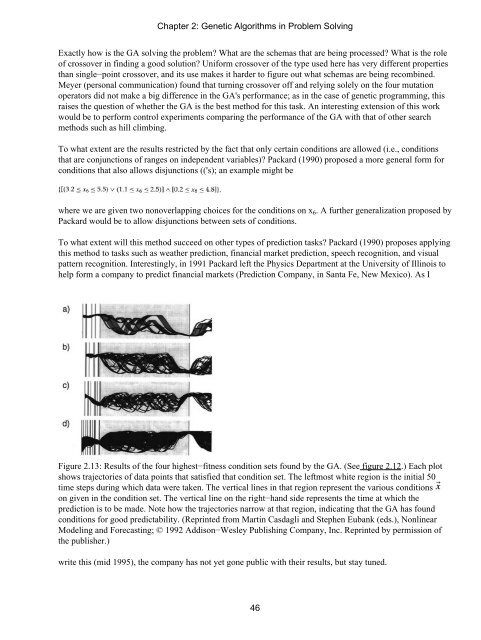An Introduction to Genetic Algorithms - Boente
An Introduction to Genetic Algorithms - Boente
An Introduction to Genetic Algorithms - Boente
You also want an ePaper? Increase the reach of your titles
YUMPU automatically turns print PDFs into web optimized ePapers that Google loves.
Chapter 2: <strong>Genetic</strong> <strong>Algorithms</strong> in Problem Solving<br />
Exactly how is the GA solving the problem? What are the schemas that are being processed? What is the role<br />
of crossover in finding a good solution? Uniform crossover of the type used here has very different properties<br />
than single−point crossover, and its use makes it harder <strong>to</strong> figure out what schemas are being recombined.<br />
Meyer (personal communication) found that turning crossover off and relying solely on the four mutation<br />
opera<strong>to</strong>rs did not make a big difference in the GA's performance; as in the case of genetic programming, this<br />
raises the question of whether the GA is the best method for this task. <strong>An</strong> interesting extension of this work<br />
would be <strong>to</strong> perform control experiments comparing the performance of the GA with that of other search<br />
methods such as hill climbing.<br />
To what extent are the results restricted by the fact that only certain conditions are allowed (i.e., conditions<br />
that are conjunctions of ranges on independent variables)? Packard (1990) proposed a more general form for<br />
conditions that also allows disjunctions (('s); an example might be<br />
where we are given two nonoverlapping choices for the conditions on x6. A further generalization proposed by<br />
Packard would be <strong>to</strong> allow disjunctions between sets of conditions.<br />
To what extent will this method succeed on other types of prediction tasks? Packard (1990) proposes applying<br />
this method <strong>to</strong> tasks such as weather prediction, financial market prediction, speech recognition, and visual<br />
pattern recognition. Interestingly, in 1991 Packard left the Physics Department at the University of Illinois <strong>to</strong><br />
help form a company <strong>to</strong> predict financial markets (Prediction Company, in Santa Fe, New Mexico). As I<br />
Figure 2.13: Results of the four highest−fitness condition sets found by the GA. (See figure 2.12.) Each plot<br />
shows trajec<strong>to</strong>ries of data points that satisfied that condition set. The leftmost white region is the initial 50<br />
time steps during which data were taken. The vertical lines in that region represent the various conditions<br />
on given in the condition set. The vertical line on the right−hand side represents the time at which the<br />
prediction is <strong>to</strong> be made. Note how the trajec<strong>to</strong>ries narrow at that region, indicating that the GA has found<br />
conditions for good predictability. (Reprinted from Martin Casdagli and Stephen Eubank (eds.), Nonlinear<br />
Modeling and Forecasting; © 1992 Addison−Wesley Publishing Company, Inc. Reprinted by permission of<br />
the publisher.)<br />
write this (mid 1995), the company has not yet gone public with their results, but stay tuned.<br />
46






